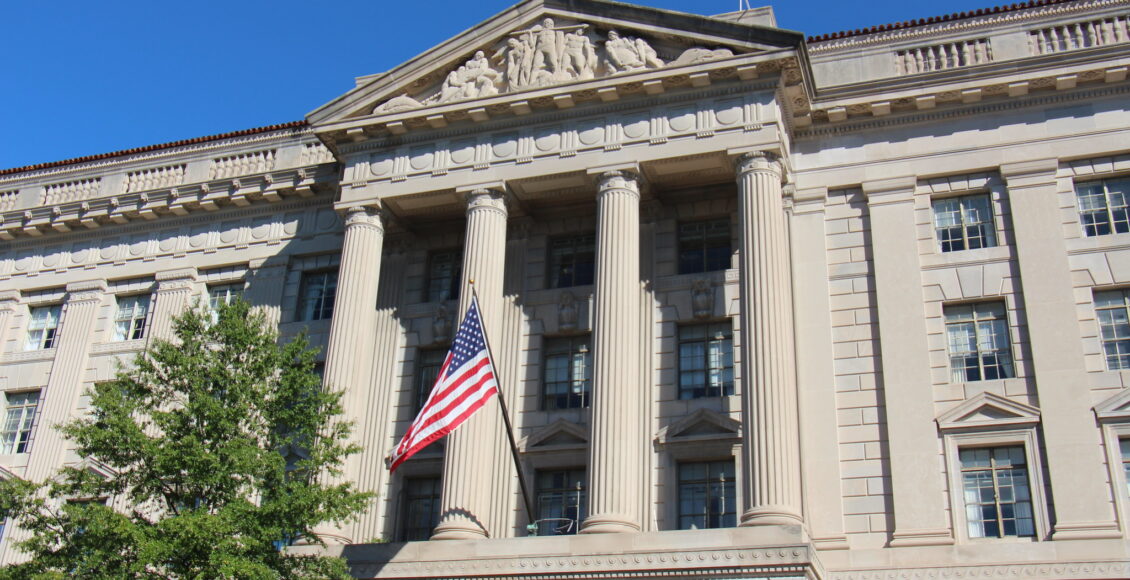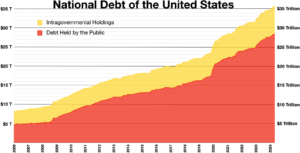From Austerity to Appetite: The Republican Shift on Fiscal Responsibility
 United States Treasury Building, Washington D.C. Photo by Irony Poisoning. Licensed under CC BY-SA 2.0.
United States Treasury Building, Washington D.C. Photo by Irony Poisoning. Licensed under CC BY-SA 2.0.
“Excessive eating has consequences,” Republican Senator Mitt Romney told business leaders in Lehi, Utah this month, “and what we’ve been doing as a country over the last 25 years has been gorging on fruit juice.” Senator Romney is not commenting on obesity rates, but on America’s other favourite indulgence — debt. Specifically, the United States’ national debt, which in 2024 surpassed $35 trillion, or approximately 124 per cent of US GDP. Romney’s unyielding concern about US debt is characteristic of the traditional Republican principle of fiscal responsibility, which was a major policy issue in Romney’s 2012 presidential campaign.
The 2000 Republican Party Platform, drafted during George W. Bush’s candidacy, devoted an entire section to championing the party’s responsible fiscal policies. Blasting Democrats for “tax-and-spend follies,” it reminded voters that under Democrat administrations between 1954 and 1994, government spending increased annually by 7.9 per cent. It contrasted this by stating that “since 1994, with Republicans leading the House and Senate, spending has been held to an annual 3.1 per cent rate of growth.” A government surplus of nearly $5 trillion was projected over ten years under Republican governance, which would be used to implement tax cuts. The platform even went as far as to say that reducing the debt ought to be enshrined as a constitutional amendment. This commitment to reducing the debt is overlooked, if not rejected, by the modern Republican Party under Donald Trump.
Similarly to a business, the US government borrows money to supplement tax revenues in funding government operations. When conducted responsibly, sovereign debt is mutually beneficial for the nation and investors. It provides a government with additional resources to invest in public services and infrastructure, which can improve economic growth. For creditors, which can be countries, organisations, or individuals, US sovereign bonds are seen as a reliable investment. The public holds approximately 80 per cent of the US national debt, which includes the Federal Reserve, foreign nations, banks, pension funds, and investors.
Throughout American history, unforeseen events have necessitated temporary increases in debt. The government’s response to both World Wars and the Great Depression required extraordinary amounts of spending. Usually, after these unexpected debt-inducing events, subsequent administrations worked to bring the debt-to-GDP ratio back to manageable levels.
During the 21st century, this pattern changed. Wars in Afghanistan and Iraq and the 2008 financial crisis led to an increase in debt as a percentage of GDP. Rising costs of social services for an ageing baby-boomer population combined with Trump’s 2017 tax cuts raised the debt to new levels. Then, in March of 2020, America was hit by the COVID-19 pandemic. Fearing a major recession and rising unemployment, the US government responded by implementing $5.6 trillion in tax cuts and stimulus packages. Between 2019 and 2022, US debt-to-GDP grew from 79 per cent to 97 per cent.

Historically, Republicans have labelled themselves as the “anti-deficit” party — though individual policymakers have differed in their levels of commitment to this principle. The Eisenhower, Nixon, and Ford administrations oversaw moderate debt increases in post-WWII decades. Reagan and Bush significantly raised the debt, though they continued to campaign on lowering the deficit. The word debt, however, is nowhere to be seen in the 2024 Republican party platform. The 2024 Republican National Convention in Milwaukee featured speeches about migrants, inflation, and cultural issues. The debt was only mentioned in passing. Estimates from the nonpartisan Committee for a Responsible Federal Budget suggest that Trump’s economic proposals would increase the debt by approximately $7.75 trillion over 10 years, compared to roughly $3.95 trillion under former candidate Harris’ plan during the same period. While the evidence has been mounting since the Reagan era, Republicans now seem to openly admit: “we are no longer the party of small deficits.”
Numerous factors are driving this policy shift, but the rise of populist politics stands out among them. When populists gain power, there is less incentive to abide by traditional ideology. Instead they seek to appease their current voting base. Policies like courting union support, fighting monopolies, and imposing tariffs reflect a shift away from traditional conservative ideology. In the past few years, they have been embraced by Trump and his allies as popular solutions. For example, The Economist argues that “Donald Trump has steered America’s conservative party to protectionism.” Protectionism refers to the implementation of tariffs to restrict international trade to boost domestic industries. Tariffs, like an inflated national deficit, are not necessarily effective policies; they are chosen to speak to voters’ grievances on rising prices and foreign competition.

As the per cent of debt relative to GDP rises, so does the relative size of annual interest payments that the government is obligated to make. In 2024, the US government spent over $1 trillion on interest payments for the $35 trillion balance of the national debt. This interest payment exceeds spending on Medicare or national defence. In the same year, the US added nearly $2 trillion to the debt.
In the 2024 presidential election, young Americans, the future bearers of the national debt, were faced with no adequate solutions to the skyrocketing debt. President-elect Trump successfully rallied voters on a variety of issues, including the economy. However, reflecting his populist rhetoric, Trump’s policies focus on lowering inflation and “bringing back” jobs, not reducing the national debt. In fact, Trump proposes establishing universal tariffs as a replacement for tax revenue, which risks raising consumers’ prices and stifling innovation and, therefore, economic growth. Vice President Harris offered a somewhat clearer approach to stabilising the debt by proposing to increase the corporate tax rate from 21 per cent to 28 per cent and increase taxes on unrealized capital gains for taxpayers with net assets of over $100 million. Neither candidate adequately addressed the debt crisis, and voters can expect the debt to continue to rise over the coming years if Trump’s policies are implemented as advertised. Economists are concerned, but young people are not. Polling shows the national debt is not a primary concern for young voters. Understandably, abortion rights, the economy, immigration, and foreign conflicts dominate the discussion in US politics.
The Peter G. Foundation, an economic think tank, warns that “young Americans are set to inherit a budget and economy that leaves them worse off than their parents…the opposite of the American dream.” As the debt-to-GDP ratio continues to rise, interest payments will constrain lawmakers. Consequences such as higher interest rates, fiscal crises, and reduced private investment threaten future prosperity. The average “Gen-Zer” will struggle to buy a home when faced with high tax rates and rising interest rates. The impacts on Americans’ retirement will be scary; Merrill Lynch, a bank, warns that by 2035 the Social Security Administration (SSA) will lack the funds to issue full benefits. Merill Lynch is referencing a SSA report which warned that “the number of people claiming benefits is rising.” This is unsustainable, because “the income from working-age people contributing to Social Security via payroll taxes is projected to stay relatively flat.” This trend is set to continue based on current demographics and birth rates.
In a pivotal shift from past principles, today’s Republican party appears increasingly indifferent to the fiscal conservatism that once defined it, even as the United States faces unprecedented debt levels. With young Americans positioned to bear the weight of this fiscal negligence, the stakes could not be higher: unchecked national debt threatens to constrict economic growth and stifle investment. The urgency to act, once championed by Republicans as a hallmark of responsible governance, now falls on an electorate that must prioritise long-term sustainability over short-term gains. If the American dream is to endure for generations to come, it is incumbent on Republican leadership to confront this mounting crisis and restore fiscal responsibility to the party’s agenda.
Edited by Grace Hodges
Featured image: US Treasury Building, Washington D.C. Photo by Irony Poisoning. Licensed under CC BY-SA 2.0.
